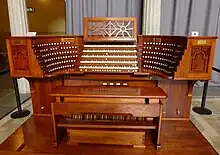Blue Hall
The Blue Hall (Swedish: Blå hallen) is the main hall of the Stockholm City Hall best known as the banquet hall for the annual Nobel Banquet, and also used for state visits, student balls, jubilees and other large events.

Description
The Hall is 50 meters (160 ft) long, 30 meters (98 ft) wide and 22 meters (72 ft) high and has a floor space of 1,500 square metres (16,000 sq ft). It contains a monumental staircase, balcony, and loggia.[1] A bust of the architect of the hall, Ragnar Östberg, is placed on the hall's rooftop terrace.[1]
The Blue Hall has brick walls which are not plastered. The hall was originally supposed to have been plastered and painted blue, a colour scheme that would have resembled the water of the bay. But Östberg changed his mind during the construction of the hall after he saw the red brick.[2][3] Though Östberg abandoned his blue design in favour of the unfinished red brick, the name "Blue Hall" was already in general use and stuck.[4][5][6]
Pipe organ

The Blue Hall contains a pipe organ known as the Stadshusorgeln (Town Hall pipe organ). The organ was dedicated in 1925. It has around 10,000 pipes and is Scandinavia's 2nd largest musical instrument.[7] Towards the end of the 1960s, the organ was rebuilt and the instrument underwent maintenance at various times afterwards, but by 2007 it was decided that the instrument needed a major overhaul and from 2007 to 2008 the pipe organ was completely renovated by the firm Harrison & Harrison in England.[7]
Use

The Hall is the site of the annual Nobel Banquet,[8] held every December 10.[3] This banquet is "the most sought-after social invitation in Sweden", attended by the Swedish royal family, government ministers, parliamentarians, and over 1200 invited guests.[9] Following the banquet, guests go to the Golden Hall, in the same complex, for dancing.[10] The Nobel Prizes are not handed out in the Blue Hall, but are given out earlier at the Stockholm Concert Hall at Hötorget.[11]
On his day each year the S:t Eriksmedaljen (St. Erik's Medal) is handed out to awardees at the Blue Hall.[12] The Blue Hall is also used for state visits, student balls, jubilees, and other large events.[8]
References
Notes
- Chattopadhyay & White 2014, p. 71.
- "Stockholms Historia av Lars Fimmerstad » Ragnar Östberg och Stockholms stadshus". Stochkolmshistoria.se. Archived from the original on 2014-10-23. Retrieved 17 October 2014.
- "Stockholm City Hall – an emblematic building". Museums in Stockholm. Archived from the original on 29 November 2014. Retrieved 15 November 2014.
- "Blå Hallen är ju…röd?". Archived from the original on 23 October 2014. Retrieved 18 October 2014.
- Larsson 2011, pp. 124–125.
- "Festlokaler". stockholm.se. Archived from the original on 22 October 2014. Retrieved 18 October 2014.
- "Stadshusorgeln". OmStockholm.se. Archived from the original on 21 October 2014. Retrieved 17 October 2014.
- "Bildspel! Nobelfesten i Blå Hallen har börjat". Svenskdam.se. Archived from the original on 22 October 2014. Retrieved 17 October 2014.
- Olah 2002, pp. 179–180.
- "The City Hall". Stockhold Visitors Board. Archived from the original on 7 August 2015. Retrieved 15 November 2014.
- Larsson 2011, p. 122.
- Larsson 2011, p. 110.
Sources
- Chattopadhyay, Swati; White, Jeremy (2014). City Halls and Civic Materialism: Towards a Global History of Urban Public Space. Routledge. ISBN 978-1317802280.
- Larsson, Rikard (2011). Murverkets hemligheter: En vägvisar till Stockholms Stadshus [Masonry Secrets: One with impact to City Hall] (in Swedish). Bokförlaget Langenskiöld. ISBN 978-9187007019.
- Olah, George A. (2002). A Life of Magic Chemistry: Autobiographical Reflections of a Nobel Prize Winner. John Wiley & Sons. ISBN 047122040X.
External links
![]() Media related to Blå hallen at Wikimedia Commons
Media related to Blå hallen at Wikimedia Commons